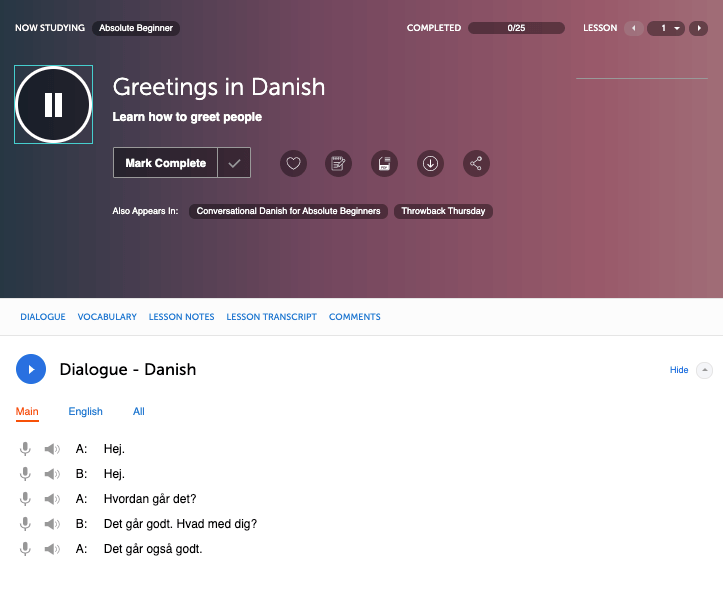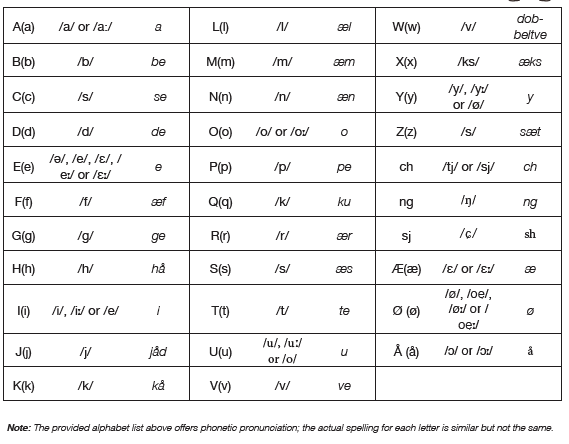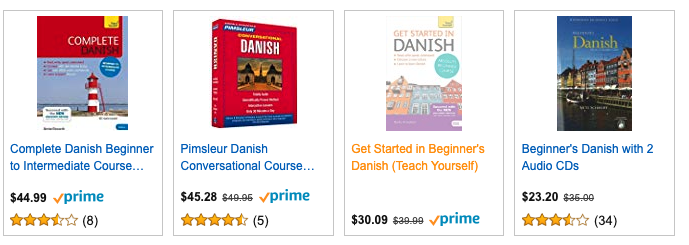Hej!
That means “hello” in Danish.
So, you want to learn Danish, eh?
Good. Keep reading. Let’s start with the simple stuff. You’ll learn the PROPER way to learn Danish so you don’t fail. Then, you’ll start speaking with easy, must-know phrases.
How to Learn Danish – For Beginners
- Learn Danish Resources
- Introduction to the Danish Language
- Danish Greetings & Common Phrases (MP3 Lesson)
- How to Count in Danish (Video Lesson)
- Is it Hard?
- How to Learn any Language with the “Right” Goals.
- Who Learns Danish?
1. Learn Danish Resources
You probably want to know what to use.
Personally, I recommend a proper textbook. You can find plenty of silly “match a picture to a word” and “rearrange these words into a phrase” apps. Should you use them? If they help… sure. But, I think you’d get a better foundation from lessons from actual teachers – whether in a textbook or in audio or videos, not apps made by programmers.
So, two good resources you can try:
Lessons are just 3-15 minutes in length. You press play on a lesson. You hear a conversation (or watch, if doing a video lesson). Then, the DanishClass101 teachers explain everything. And the result is: you learn a new conversation in a few minutes.

Click here to start learning Danish at DanishClass101.
- B) Danish Textbooks on Amazon.
Click through and pick one that has good enough reviews. Note: the Amazon link is my affiliate link.
2. Introduction to the Danish Language
Danish is a North Germanic language with about 6,000,00 speakers as of 2019. And, as you figured, it’s spoken mainly in Denmark, as well as Iceland.
Which languages is Danish similar to? Other Scandinavian countries like Swedish and Norwegian. These 3 languages are somewhat mutually intelligible.
Okay, now what about the Danish language?
Here’s how it sounds like. Press play to listen.
Here’s what the Danish Alphabet looks like.
Doesn’t look too different, eh?
There are 20 consonants and 9 vowels. And with those 9 vowels, you can make 20 vowel sounds,
3. Danish Greetings & Common Phrases (MP3 Lesson)
Press play on the lesson below to listen to how Danish sounds and to learn greetings.
- Hej
- Hi/Hello
- Goddag
- Good day
- Vi ses
- See you
Here are some more Danish phrases you should know:
- Hvad så?
- What’s up?
- Hvordan går det?
- How are you?
- Tak.
- Thank you.
- Jeg har det fint.
- I’m fine.
- Jeg har det godt.
- I’m great.
- Og dig?
- And you?
- Mit navn er _____.
- My name is _____.
- Jeg er fra Danmark.
- I’m from Denmark.
If you want to learn to introduce yourself in Danish, check out my other article here.
4. How to Count in Danish
Danish numbers from 1 to 10.
1. En
2. To
3. Tre
4. Fire
5. Fem
6. Seks
7. Syv
8. Otte
9. Ni
10. Ti
5. Is it Hard to Learn Danish?
Now, is it hard?
If you’re an English speaker, don’t worry too much.
Yes, the sounds are a bit different. Yes, there are not too many word and grammatical similarities . Yes, it will take time. Yes, you will have trouble remembering some words. But if you approach it from the “yes, I can learn it if I apply enough time and consistency,” you’re good to go.
If you think “nah, sounds too hard,” your journey is over right here.
But here are some basic facts:
- Danish is easy for people that know a Scandinavian language already like Swedish and Norwegian. Why? Same letters. Similar sounds.
- Danish is challenging if you’re a Chinese speaker. Why? Because there’s a big difference between your native language and Danish.
- The Foreign Service Institute (FSI) ranks Danish as a Category 1 language. Not harder than Spanish, Italian or French.
- Category 1 means that it’s close enough to English and requires up to 600 hours of study. Not a lot.
So, don’t let that scare you. Millions of people are learning Japanese and Chinese, which are Category 4 languages (1,100+ hours), out of pure interest and succeeding. Why? Because they’re interested. Because they think they can succeed and so, they do.
6. How Do You Learn Danish?
Let’s say you answered with a “yes, I can!” in the part above.
What’s next? Do you go get some textbooks? Sure. You should get some resource.
But first, let’s make sure you DON’T QUIT.
Let’s talk about setting language goals. “I want to learn Danish” is a big, VAGUE goal. How will you do it? What will you use? And what will you do on days when you “feel tired.”
The way to learn Danish or any language is to… set small, measurable, easier, achievable goals with a deadline. Here are some examples:
- Learn 100 Danish Words this month. By March 31st (or whenever).
- Listen to 16 Danish Audio Lessons by January 31st.
- Finish the 1st Chapter of a Textbook this month. By August 31st
- Memorize 25 phrases in 1 week. By November 15th.
- Be able to speak Danish for at least 1 minute this month. By December 31st.
Now, take a look: All of these are measurable. Either you can speak 1 minute or know 100 words… or you don’t. Plus the goals are small and easy – what’s learning 100 words compared to tens of thousands in the language? Finally, the deadline gives you a date to aim for.
Set goals like this and you’ll be OK.
7. Who Actually Learns Danish?
Well, since you’re here reading this, please leave ME a comment. Tell me why you’re learning Danish.
But, if you’re curious about other people, here are some examples:



Translation: Traveling to Denmark.


Translation: “I want to understand my Danish friends”

So, back to you? Why are you learning Danish? Leave me a comment.
And that’s it.
I’ll update this guide as I go along. Right now, this is just for starters.
Hope you enjoyed this!
– The Main Junkie
